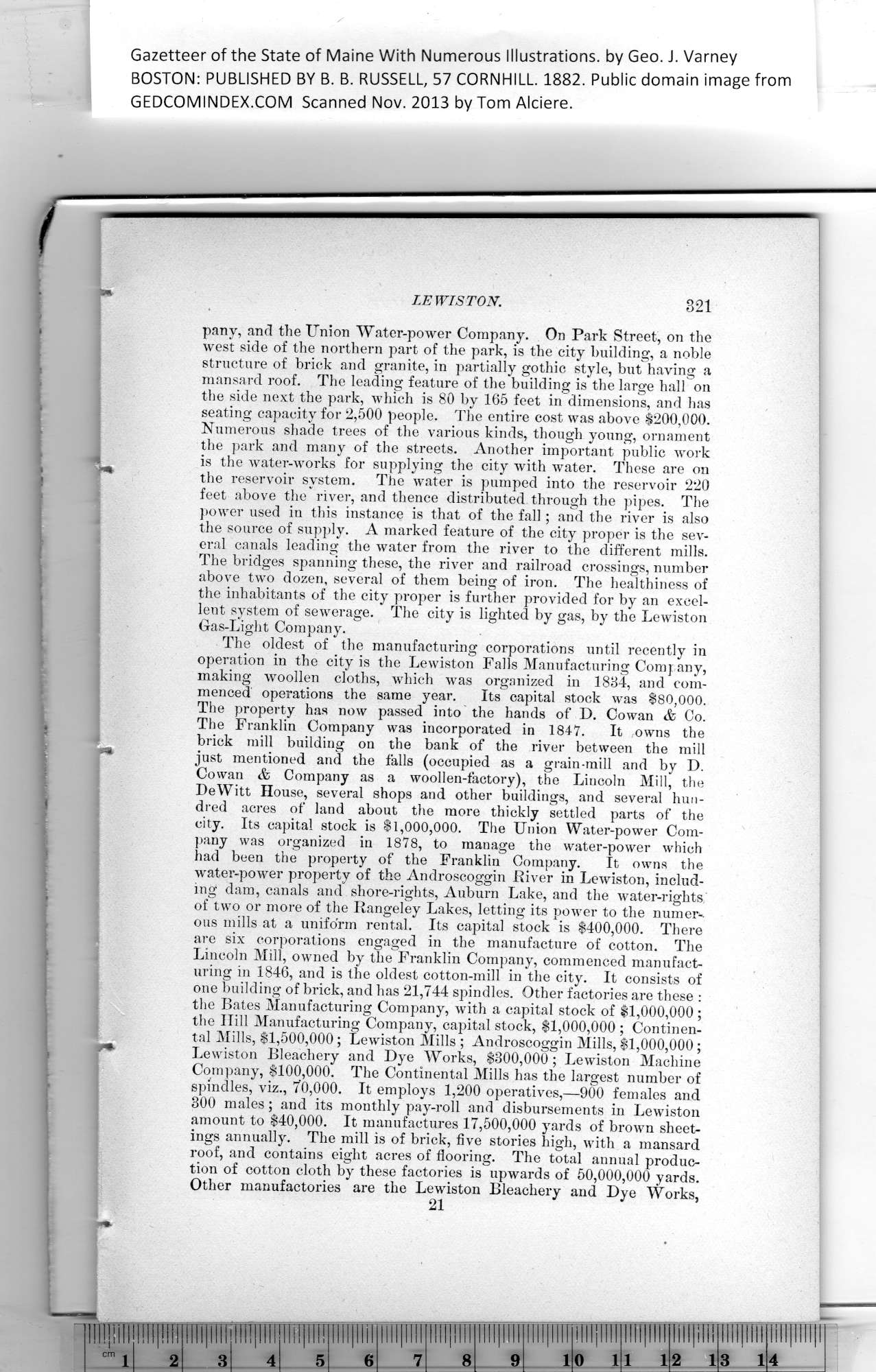|
Gazetteer of the State of Maine With Numerous Illustrations, by Geo. J. Varney
BOSTON: PUBLISHED BY B. B. RUSSELL, 57 CORNHILL. 1882. Public domain image from
pany, and the Union Water-power Company. On Park Street, on the
west side of the northern part of the park, is the city building, a noble
structure of brick and granite, in partially gothic style, but having a
mansard roof. The leading feature of the building is the large hall on
the side next the park, which is 80 by 165 feet in dimensions, and has
seating capacity for 2,500 people. The entire cost was above $200,000.
Numerous shade trees of the various kinds, though young, ornament
the park and many of the streets. Another important public work
is the water-works for supplying the city with water. These are on
the reservoir system. The water is pumped into the reservoir 220
feet above the river, and thence distributed through the pipes. The
power used in this instance is that of the fall; and the river is also
the source of supply. A marked feature of the city proper is the sev-
eral canals leading the water from the river to the different mills.
The bridges spanning these, the river and railroad crossings, number
above two dozen, several of them being of iron. The healthiness of
the inhabitants of the city proper is further provided for by an excel-
lent system of sewerage. The city is lighted by gas, by the Lewiston
Gas-Light Company.
The oldest of the manufacturing corporations until recently in
operation in the city is the Lewiston Falls Manufacturing Company,
making woollen cloths, which was organized in 1884, and com-
menced' operations the same year. Its capital stock was $80,000.
The property has now passed into the hands of D. Cowan & Co.
The Franklin Company was incorporated in 1847. It owns the
brick mill building on the bank of the river between the mill
just mentioned and the falls (occupied as a grain-mill and by D.
Cowan & Company as a woollen-factory), the Lincoln Mill, the
DeWitt House, several shops and other buildings, and several hun-
dred acres of land about the more thickly settled parts of the
city. Its capital stock is $1,000,000. The Union Water-power Com-
pany was organized in 1878, to manage the water-power which
had been the property of the Franklin Company. It owns the
water-power property of the Androscoggin River in Lewiston, includ-
ing dam, canals and shore-rights, Auburn Lake, and the water-rights/
of two or more of the Rangeley Lakes, letting its power to the numer-
ous mills at a uniform rental. Its capital stock is $400,000. There
are six corporations engaged in the manufacture of cotton. The
Lincoln Mill, owned by the Franklin Company, commenced manufact-
uring in 1846, and is the oldest cotton-mill in the city. It consists of
one building of brick, and has 21,744 spindles. Other factories are these :
the Bates Manufacturing Company, with a capital stock of $1,000,000;
the Hill Manufacturing Company, capital stock, $1,000,000 ; Continen-
tal Mills, $1,500,000; Lewiston Mills ; Androscoggin Mills, $1,000,000;
Lewiston Bleachery and Dye Works, $300,000; Letviston Machine
Company, $100,000. The Continental Mills has the largest number of
spindles, viz., 70,000. It employs 1,200 operatives,—900 females and
300 males; and its monthly pay-roll and disbursements in Lewiston
amount to $40,000. It manufactures 17,500,000 yards of brown sheet-
ings annually. The mill is of brick, five stories high, with a mansard
roof, and contains eight acres of flooring. The total annual produc-
tion of cotton cloth by these factories is upwards of 50,000,000 yards.
Other manufactories are the Lewiston Bleachery and Dye Works,
PREVIOUS PAGE ... NEXT PAGE
This page was written in HTML using a program written in Python 3.2
|
